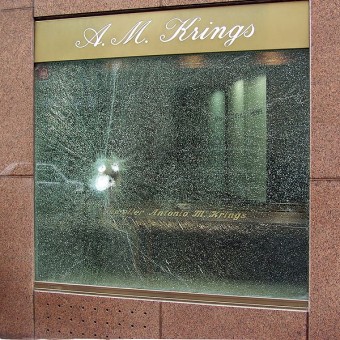There is No Such a Thing as Bulletproof Glass
 Myth: There is such a thing as true bulletproof glass
Myth: There is such a thing as true bulletproof glass
In movies and TV shows, bulletproof glass is often depicted to be indestructible. No matter what weapon is used, no matter how many bullets are fired, bulletproof glass remains intact and unchanged. The only problem is, in real life, bulletproof glass isn’t really bulletproof and it isn’t really glass.
The correct term for “bulletproof” glass is bullet resistant. Why? Because with enough time and concentrated effort or just a big enough caliber bullet, a person can become victorious over the supposed indestructibility of “bulletproof” glass. The strength and durability of bullet-resistant glass depends on how it is made and the thickness of the final product.
Fire a bullet at a normal sheet of glass and the glass will shatter, right? So, how exactly does glass become bullet resistant? There are three main kinds of bullet-resistant glass:
1) Acrylic: Acrylic is a hard, clear plastic that resembles glass. A single piece of acrylic with a thickness over one inch is considered bullet resistant. The advantage of acrylic is that it is stronger than glass, more impact resistant, and weighs 50 percent less than glass. Although acrylic can be used to create bullet-resistant glass, there is no actual glass in the final product.
2) Polycarbonate: Polycarbonate is also a type of plastic, but it differs from acrylic in many ways. Polycarbonate is a versatile, soft plastic with unbeatable strength. It is a third of the weight of acrylic and a sixth of the weight of glass, making it easier to work with, especially when dealing with thickness. Polycarbonate is combined in layers to create a bullet resistant product. Whereas, acrylic repels bullets, polycarbonate catches the bullet and absorbs its energy, preventing it from exiting out the other side. Polycarbonate is more expensive than other types of materials, including glass and acrylic, so it is often used in combination with other materials for bullet-resistant glass.
3) Glass-Clad Polycarbonate Bullet-Resistant Glass: This type of bullet-resistant glass uses a combination of materials to create the desired result. We are all familiar with the process of lamination. It is what teachers do to paper to protect it from the unidentifiable substances of kids’ fingers so it will last longer. Manufacturers of glass-clad polycarbonate bullet-resistant glass use the same process. A piece of polycarbonate material is laminated, or sandwiched, between ordinary sheets of glass and then it undergoes a heating and cooling process to mold the materials together into one piece. The end result is a product that resembles glass but is thicker and more durable.
Thickness plays a huge part in a product’s ability to resist bullets. Bullet-resistant glass is designed to remain intact for one bullet or one round of bullets. Depending on the force of the bullet being fired and what type of weapon is used, a thicker piece of bullet-resistant glass is needed to stop a bullet with more force. For instance, a shot fired from a 9mm pistol is less powerful than one fired from a rifle. Therefore, the required thickness of bullet-resistant glass for a 9mm pistol is less than is needed for a rifle. The final thickness of bullet-resistant glass usually ranges from about .25 inches to 3 inches.
The latest and greatest design for bullet-resistant glass is one-way bullet-resistant glass. Yes, it is exactly what is sounds like. One-way bullet-resistant glass consists of two layers–brittle glass and a flexible material such as the polycarbonate plastic material described above. When a bullet hits the brittle glass layer first, the glass breaks inward toward the plastic, which absorbs some of the bullet’s energy and spreads it over a larger area so the polycarbonate material is able to stop the bullet from exiting. When a fired bullet hits the polycarbonate material first, the bulk of the force is concentrated on a small area that prevents much energy from being absorbed. Then, since the glass material breaks outward away from the polycarbonate, the bullet maintains enough energy to break through the glass and travel toward its destination. One-way bullet-resistant glass is most ideal for armored vehicles.
The moral of the story is don’t believe everything you see. Although movies do a good job to entertain us and teach us a thing or two, the truth about bullet-resistant glass is not one of them.
Bonus Facts:
- Depending on the size and type of bullet-resistant glass, it can cost between $25 and $100 per square foot.
- Although polycarbonate plastic can bond with glass to resist bullets, paper towels can scratch its surface and ammonia-based window cleaning liquids will damage the material.
- Obtaining bullet-resistant glass is completely legal in the United States. You don’t even need a permit.
- The most popular bullet-resistant product in demand is bulletproof transaction windows like those used in banks.
- Ever thought about making your beloved iPad bulletproof? A company in California created an iPad cover made of polycarbonate material to better protect the device. Although the new transparent cover will protect the screen from scratches, dents, and shattered glass, there is no guarantee that the bullet-resistant material will actually stop a bullet.
- A sheet of polycarbonate plastic can take an hour beating with a sledgehammer, whereas, an acrylic piece of comparable thickness might succumb in minutes.
| Share the Knowledge! |
|





YOU LIE!
@WiLIArD: err. no… you lie… Q.E.D.
Explain this
http://www.wimp.com/unbreakableglass/
@Leslie: It’s not truly glass, that’s just what it is called.
Yeah, but what about force-fields? They’re real, right?
No they aren’t!
Polycarbonate is not 1/3 the weight of Acrylic both weigh about the same, about 1.20 g/cm3